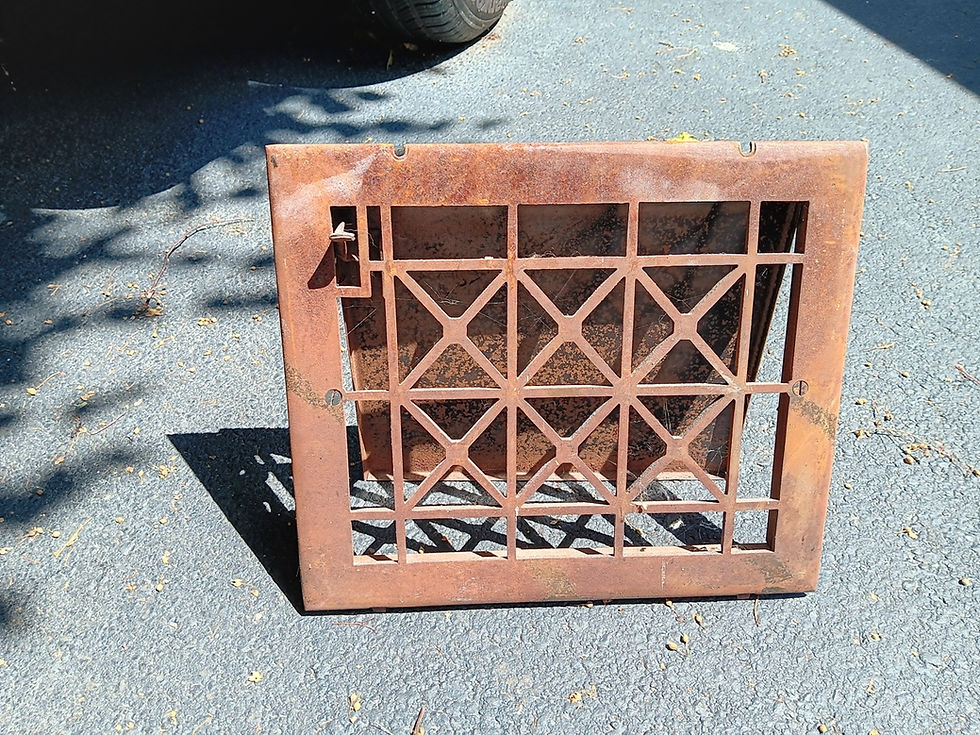Ideas from Ed: More door (Part 2 of 2) (Volume 8, Issue 6)
- edwardpetrus

- Jul 1
- 3 min read
Last month I featured the basic build of the basement door pictured below. If you didn’t read that article, perhaps you should do so before seeing how that project was completed and installed. Here is the link: https://www.lcppreserve.org/post/ideas-from-ed-more-door-part-1-of-2-volume-8-issue-5

This is the basement entrance and the inner door that will be protected by this storm door.

You may recall me noting that the doorway wasn’t square, so the first step in fitting the door was to carefully determine what was “off” and by how much. Here’s a framing square placed against the top of the doorway. As you can see, there’s about a 1/8” difference from side to side.

The width of the doorway wasn’t too far off, but varied from nearly 28 ¼” to just under 28” in these top, middle, and bottom pictures.



The “slightly crooked” door height and width were drawn onto the new door, and I proceeded to cut things closer to what I thought would be a decent fit. I planned to reserve any final adjustments to a hand plane. All of the work on this door has been at my home, not on site, so I had to be very careful and accurate with all measurements. I used my typical clamped-on straightedge to guide my circular saw as I made the cuts. Remember, the door was purposely built just a bit oversized in anticipation of making these adjustments. I made the cuts with the saw blade about two degrees from plumb. That should make it fit into the space just a bit better and make any shaving with the hand plane a tad easier.

Although I had the old door insert (with the Plexiglas panes) in hand at my house, I took advantage of a trip to the work site to remove the old storm door frame. That meant pulling the pins in the hinges. They had been painted over many times but finally succumbed to repeated tapping with a screwdriver/hammer combination. I left the other half of each hinge in place in the doorway.

I tore the door apart. In reality, it just fell apart since it was so rotted. However, I did save the vertical section with the hinges. Later, back at my house, I clamped that section against the new door and carefully marked the hinge locations.

I took about ten minutes with one of my favorite tools, my bench-mounted motor with a brass wire wheel on its arbor, to clean up the hinges and their pins.


Although using a chisel isn’t my strongest suit, I carefully dug out the recesses into which each hinge would be installed. The “secret” in doing a good job is to go slowly and have a very sharp chisel.


Here’s the door with all three hinges installed using 2” long stainless steel screws.

I drove the door to its home two hours away. I was hoping the careful measurements I made to fit the hinges in place would allow me to simply slip the door into position on the other halves of the hinges, which were still attached to the door jamb. The fit was good, but it was still easier to remove the old hinge sections and attach them to the door hinges with the pins and then position the whole unit in place.

I used 2 ½” ceramic-coated screws in the door hinge pieces. This is a heavy door, and I wanted to be sure to make all connections as strong as possible. Someone “down the road” will likely complain that two different screw types were used (stainless steel Phillips-head in the door and ceramic Torx in the jamb) but I’m not fussing over that.

I’m not showing much of the knob installation because it was straightforward, and if you were doing this job, it’s likely that your knob would not be the same as the one I used. This one required two through-holes for attaching screws and one slightly larger and centered for the actual mechanism’s shaft. It was just a matter of following the instructions that came with the knob set.

Here’s the door still needing a bit of trim installed around the inside edges, a sweep at the bottom, and of course, coats of primer and paint.

Finally, here it is after a coat of primer.

I hope all your projects go well. Thanks for reading, and happy restoring!
Ed
If you’d like to download a PDF of this “Ideas” column, click here:




Comments